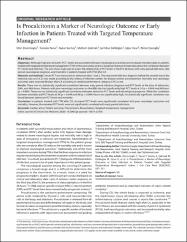| dc.contributor.author | Zincircioğlu, Çiler | |
| dc.contributor.author | Yavuz, Tunzala | |
| dc.contributor.author | Sarıtaş, Aykut | |
| dc.contributor.author | Çakmak, Meltem | |
| dc.contributor.author | Köse Güldoğan, Işıl | |
| dc.contributor.author | Uzun, Uğur | |
| dc.contributor.author | Şenoğlu, Nimet | |
| dc.date.accessioned | 2021-05-05T22:14:09Z | |
| dc.date.available | 2021-05-05T22:14:09Z | |
| dc.date.issued | 2020 | |
| dc.identifier.issn | 0972-5229 | |
| dc.identifier.issn | 1998-359X | |
| dc.identifier.uri | https://doi.org/10.5005/jp-journals-10071-23418 | |
| dc.identifier.uri | https://hdl.handle.net/20.500.12933/329 | |
| dc.description | WOS:000571019700010 | en_US |
| dc.description | PubMed: 32728323 | en_US |
| dc.description.abstract | Objectives: Although high procalcitonin (PCT) levels are associated with poor neurological outcomes and increased mortality rates in patients treated with targeted temperature management (TTM) in the postcardiac arrest (CA) period, there are limited data about the correlation between PCT levels and infection. The aim of our study was to assess the relationship of PCT levels in the first 48 hours with early period infections, late period neurological prognosis, and mortality in patients treated with TTM after CA. Materials and methods: Serum PCT was measured on admission days 1 and 2. The early onset infection diagnosis before the seventh day in the intensive care unit (ICU) was made according to the criteria of infection centers for disease control and prevention. Mortality and neurologic outcomes were assessed 90 days after CA according to cerebral performance category (CPC) score. Results: There was no statistically significant correlation between early period infection diagnosis and PCT levels at the time of admission, 24th, and 48th hours. Patients with poor neurologic outcomes on the 90th day had significantly high PCT levels at 24 (p = 0.044) and 48 hours (p = 0.004). There was no statistically significant correlation between admission PCT levels and neurological prognosis. While the correlation between mortality and PCT levels at 24 (p = 0.049) and 48 (p = 0.004) hours was significantly high, no statistically significant correlation was found between admission PCT levels and mortality. Conclusion: In patients treated with TTM after CA, increased PCT levels were significantly correlated with poor neurologic outcomes and mortality. However, the elevated PCT levels were not significantly correlated with early period infections. | en_US |
| dc.language.iso | eng | en_US |
| dc.publisher | Jaypee Brothers Medical Publishers Pvt Ltd | en_US |
| dc.rights | info:eu-repo/semantics/openAccess | en_US |
| dc.subject | Cardiac arrest | en_US |
| dc.subject | Patient outcome | en_US |
| dc.subject | Procalcitonin | en_US |
| dc.subject | Resuscitation | en_US |
| dc.subject | Targeted temperature management | en_US |
| dc.title | Is Procalcitonin a Marker of Neurologic Outcome or Early Infection in Patients Treated with Targeted Temperature Management? | en_US |
| dc.type | article | en_US |
| dc.department | AFSÜ, Tıp Fakültesi, Cerrahi Tıp Bilimleri Bölümü, Anesteziyoloji ve Reanimasyon Ana Bilim Dalı | en_US |
| dc.contributor.institutionauthor | Yavuz, Tunzala | |
| dc.identifier.doi | 10.5005/jp-journals-10071-23418 | |
| dc.identifier.volume | 24 | en_US |
| dc.identifier.issue | 5 | en_US |
| dc.identifier.startpage | 327 | en_US |
| dc.identifier.endpage | 331 | en_US |
| dc.relation.journal | Indian Journal Of Critical Care Medicine | en_US |
| dc.relation.publicationcategory | Makale - Uluslararası Hakemli Dergi - Kurum Öğretim Elemanı | en_US |
















